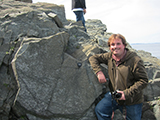Tag: Marc Laflamme

Marc’s research interests lie in the classification, function and preservation of the Ediacara biota, the oldest large and complex organisms in the rock record. These globally distributed soft-bodied organisms abruptly appear in the fossil record some 578 million years ago, and represent the dominant members of early ecosystems up until the Cambrian explosion of complex animals. Marc’s research focuses on understanding the preservation of soft tissues in the fossil record, combining laboratory decay experiments with extensive field-based studies in Newfoundland, South Australia and Namibia.
Contact Details:
Dr. Marc Laflamme, Department of Chemical and Physical Sciences, University of Toronto Mississauga, Mississauga, Ontario, Canada.